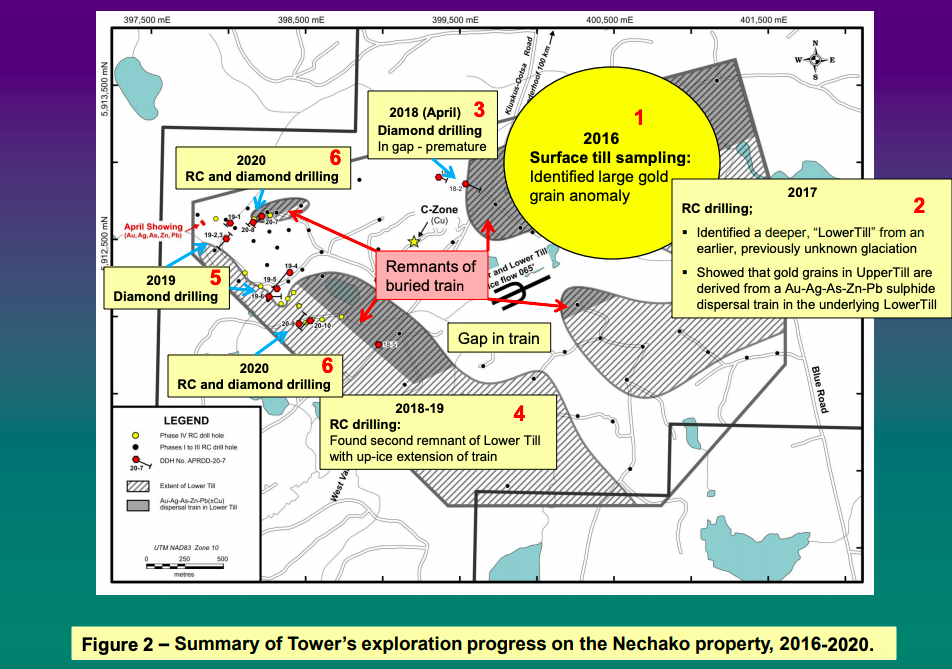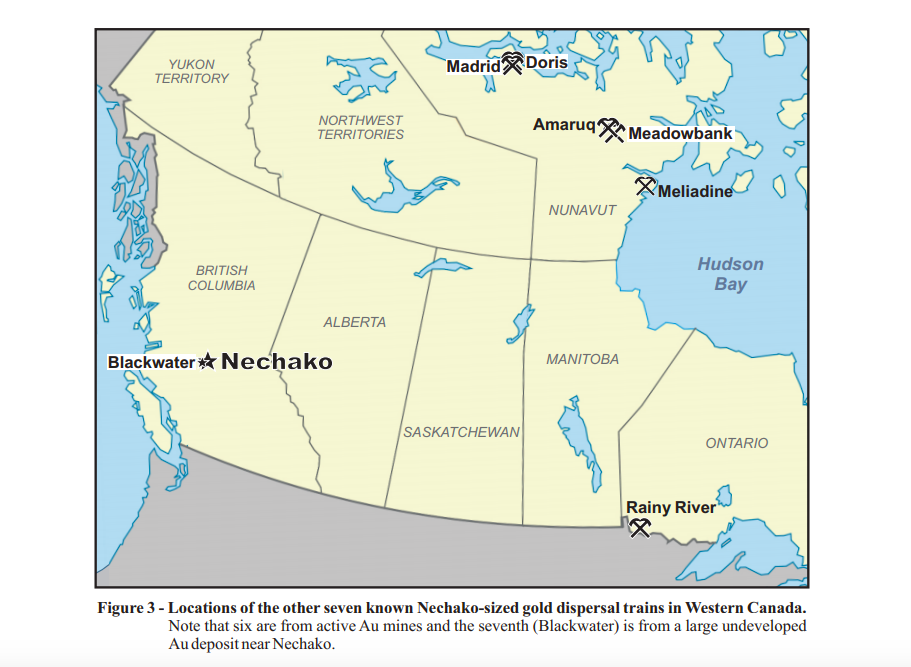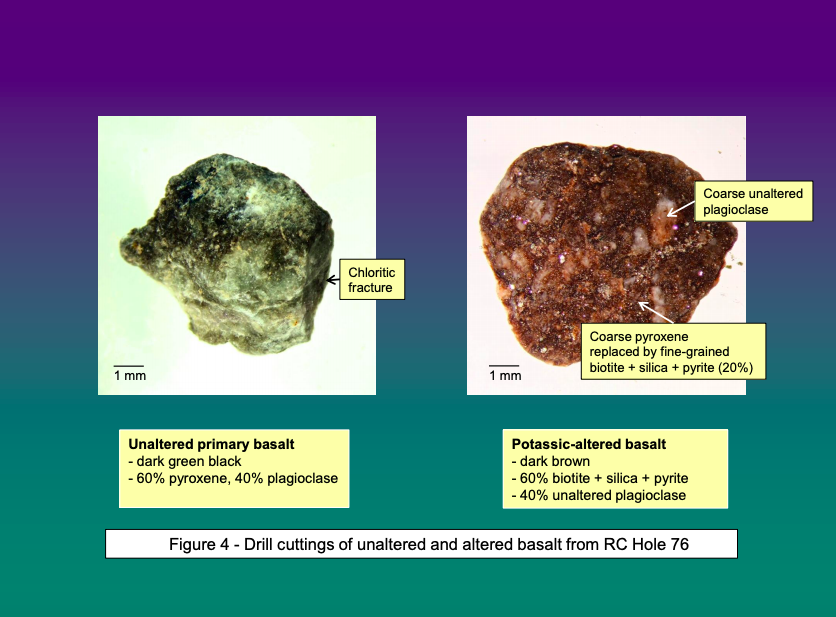Vancouver, B.C. – May 6, 2020 - Tower Resources Ltd. (“Tower” or the “Company”) (TSXV: TWR) is pleased to report partial results from its recent Reverse Circulation (RC) and Diamond Drilling (DD) program on the April Trend on the Company’s Nechako, BC property (Fig. 1), including a 7.1 m core intercept grading 2.75 g/t Au, 40.2 g/t (1.2 oz/ton) Ag, 0.30% Zn and 0.28% Pb in Hole APR20-10, the last hole of the short, 4-hole, 393.1 m DD program.
The April Trend is located at the head of a large (1.5 km wide x >3 km long), strong, Au-Ag-Zn-Pb-As glacial dispersal train in till (Fig. 2). Only seven other gold dispersal trains of this stature are known in Western Canada, of which six are associated with active gold mines and the seventh with the 8-million-ounce Blackwater gold deposit 30 km southwest of the Nechako property (Fig. 3).
The Nechako dispersal train contains the same suite of elements – Au, Ag, Zn, Pb and As – as the Eskay Creek Deposit in northern BC, the highest-grade Au-Ag deposit of its size ever mined in Canada (2.2 million tones @ 45 g/t gold and 2,224 g/t silver). Moreover, the ratio of Au and Ag to Zn, Pb and As in both the heavy mineral concentrates of the till samples and the discovery zone in Hole 10 (Table 1) is very high, suggesting that mineralized zones along the April Trend with only a few percent As, Zn and Pb sulphides may contain economic grades of gold and silver.
Tower’s new discovery was obtained after just 1000 m of diamond drilling along the new April Trend. The mineralized zone occurs within a siliceous, Eskay Creek-type siltstone-mudstone horizon atop an intense, 800 m wide x 500 m thick alteration pipe in the underlying basalt (Fig. 1). The immense size of this pipe reflects the unusually large scale of the hydrothermal alteration system that introduced the mineralization and attests to the high potential for economic gold-silver deposits along the April Trend.
Joe Dhami, President and CEO, commented: “Our Nechako property is located in one of lowest cost areas of BC and is accessible year round. We have strategically managed our work plans to utilize the experience and technical expertise of our team and now they will focus on expanding the Discovery zone and fully testing the exceptional gold-silver potential along the April Trend.”
Stu Averill, P.Geo., a Director of the Company, added: “Now that we have identified the fundamental controls on hydrothermal alteration and mineralization, we can make effective use of IP and ground magnetic surveys, in addition to RC drilling, to identify areas of sulphide enrichment even more efficiently and thereby accelerate the discovery and delineation of Au-Ag-Zn-Pb deposits along the April Trend.”
The Path to Discovery
Tower identified the tail of the Nechako Au-Ag-Zn-Pb-As dispersal train on the eastern part of the property in 2017 by RC drilling beneath a gold grain anomaly that the Company had outlined in a surface till heavy mineral survey the previous year (Fig. 2). The Au In the till heavy mineral concentrates was found to be sympathetic and proportional to As while Ag was sympathetic and proportional to Zn+Pb, and the ratio of Au and Ag to these associated metals, in g/t to percent, was very high at approximately 4:1 and 70:1, respectively, suggesting a high potential for a source of economic Au and Ag grades. While the gold grains at surface are clearly derived from the underlying dispersal train, the train itself is not exposed; it occurs at depths greater than 15-20 m within an older till horizon that was deposited by an earlier glaciation. Moreover, a large, 1 km gap is present in the middle of the train where the glacial deposits are thinner and the host till was completely eroded during the last glaciation.
Tower undertook two additional RC drilling campaigns further west across the gap in late 2018 and early 2019. These programs succeeded in both locating the stronger head of the train (Fig. 2) and intersecting highly altered bedrock beneath it (Fig. 1). An initial 6-hole, 630 m follow-up diamond drilling program was then undertaken in August, 2019. Favourable mudstone and sulphide bearing conglomerate similar to those at Eskay Creek were intersected in the sixth hole, No. APR19-06 but the only significant mineralization was a 0.2 m wide sulphide vein grading 2.93 g/t Au, 34.3 g/t Ag, 5.45% Zn, 0.60% Pb and 0.23% As (see September 20, 2019, press release).
The total cost of the 2018-2019 RC and DD programs along the April Trend and the recent RC/DD discovery program was just $600,000 and only 1000 m of diamond drilling was required, illustrating both the low cost of exploring in the Nechako area and the efficiency of Tower’s exploration team.
The Discovery Zone
The new gold-silver zone in DD hole No. APR20-10 is hosted by the same sediment horizon as and lies approximately 250 m southeast along strike from the mineralized vein that was previously intersected in APR19-06 (Fig. 1). Hole 10 was drilled to undercut one of the new RC drill holes, No. NRC20-74, which encountered 3 m of similar sediments with visible arsenopyrite immediately below the till.
The sediment horizon appears to be subvertical and its core thickness (all DD holes were drilled at -45꙳ whereas the RC holes were vertical) increases from <10 m at Hole 06 to ~30 m at Hole 10. The sediments consist of hard (siliceous), thinly laminated, black, grey and brick-red mudstone and siltstone with minor centimetric bands of paler, fine-grained sandstone. They are highly fractured, apparently by the same forces that made the underlying massive basalt permeable to the hydrothermal fluids that produced the alteration pipe. Consequently they are very blocky and difficult to core, commonly resulting in poor core recovery. The fractures tend to be lined with a mix of sulphide minerals that variably include pyrite, arsenopyrite, sphalerite and galena but neither pyrrhotite nor chalcopyrite.
In Hole 10, the sediments are split by a post-mineralization dyke of biotite-feldspar porphyry related to the Kluskus Road and Blue Road stocks to the east. The 7.1 m mineralized zone occurs in the sediments immediately below the porphyry, starting at a down-hole depth of 51.8 m (Table 1). It encompasses five samples ranging in length from 0.8 to 1.8 m. The middle sample, measuring 1.3 m, contained only anomalous levels of Au (0.123 g/t) and Ag (5.9 g/t). In the other four samples, Au varies from 0.48 to 9.43 g/t while Ag is a more uniform 34.0 to 67.3 g/t. The average ratio of Au to As, in g/t to percent, is 2.3:1 while that of Ag to Zn+Pb) is 69:1
The sediment section above the porphyry dyke, from 34.9 to 45.5 m, is so fractured that insufficient core was recovered for meaningful analysis. However, two small (0.15 and 0.4 kg), sphalerite and galena-rich but arsenopyrite-poor specimens from 42.6-42.7 and 44.2-44.4 m were analyzed to determine metal ratios. As expected from the known sympathetic relationships between Ag-Zn-Pb and Au-As, they yielded very high Ag values of 545 g/t (15.9 oz/ton) and 74.7 g/t (2.2 oz/ton), respectively, but lesser Au values of 1.13 and 0.72 g/t.
Hole 09 was drilled ~40 m northwest along strike from Hole 10 but in the opposite direction (Fig. 1). The mineralized zone in this hole is interrupted by a fault-bounded, 4-m-wide slice of basalt within the host sediments. Narrow sulphide veins are present in both the basalt and sediments, the most significant being in a 0.2 m wide zone that assayed 1.6 g/t Au, 27.7 g/t Ag, 0.87% Zn, 0.18% Pb and 1.06% As.
Character and Importance of the Alteration Pipe
The alteration pipe that stratigraphically underlies the mineralized sediments is very large and the alteration is intense and visually conspicuous. However, the pipe was not recognized until the recent, 15-hole RC drilling program because it is completely covered by till and the earlier RC holes were more widely spaced.
The alteration is of the potassic type and has selectively affected the primary mafic (i.e. Fe and Mg-bearing) silicate minerals in the rock rather than the feldspar. Consequently it is best-developed in the basalt, the rock with the highest mafic mineral content (~50% augite). In the most-altered basalt intercepts, this augite has been completely replaced by a very fine-grained mixture of two other Fe-bearing minerals, biotite and pyrite (or locally pyrrhotite), plus silica (quartz), changing the colour of the basalt from dark green to brown (Fig. 4). Since biotite contains significant potassium and augite does not, the alteration reaction involved addition of this element from the hydrothermal fluid, raising the usual 1-2% K2O content of the basalt to 4-5%.
As basalt is normally a massive, impervious rock, pervasive preparatory fracturing was required to admit the fluid that that caused the alteration. This fracturing is visible throughout the green, unaltered basalt at centimetre to metre scale. The fracture surfaces tend to be coated with sheets of chlorite (Fig. 4a) that are commonly striated, indicating slippage and incipient brecciation. The fractures are oriented preferentially to the southeast parallel to the drill core, a situation that causes significant core breakage and loss. In the brown basalt within the alteration pipe, the alteration minerals have sealed these fractures (Fig. 4b), improving both drilling productivity and core recovery.
The alteration pipe appears to have originated at a stratiform breccia horizon, interpreted as the fluid reservoir, about 500 m below the mineralized sediments and to have propagated upward into a broad funnel (Fig. 1). Importantly, the most southwesterly RC drill holes show that the alteration extends across the mineralized sediments into another, overlying basalt horizon, suggesting that a second mineralized horizon is present along a parallel creek lineament ~150 m further to the southwest.
The stratiform breccia horizon below the alteration pipe was tentatively logged as dacitic breccia but is unlike any of the common volcaniclastic breccias and may itself be of hydrothermal origin. It thickens to the northwest into a “dome” in which the breccia has undergone brown biotitic alteration similar to that in the alteration pipe in the basalt and is variably mineralized with the same metals. A small Au-Ag-Zn-Pb-As dispersal train was intersected in RC holes drilled down-ice from this dome and north of the main dispersal train (Fig. 2). The first two diamond drill holes of the present program, Nos. APR20-07 and 08, were drilled on this dome (Fig. 1). The breccia in Hole 07 is broadly anomalous in Au and Ag, and a 0.4 m, sulphide-rich interval from 71.8 to 72.2 m returned 3.92 g/t Au, 152 g/t (4.4 oz/ton) Ag, 3.1% As and 4.9% Zn plus, unusually, 0.53% Cu but negligible (0.07%) Pb.
Next Steps
The April Trend is completely covered by thick glacial deposits and the buried till horizon that hosts the Nechako dispersal train was intersected in 8 of the 15 recent RC drill holes, mainly those closest to the mineralized sediments and thus of most exploration interest. The till samples from these holes have not yet been processed due to temporary closure of the ODM heavy mineral laboratory during the current COVID-19 epidemic, but will be tested before exploration resumes on the Nechako property.
No ground geophysical surveys have ever been performed along the April Trend. Tower now has sufficient knowledge, primarily from the RC drill holes, of the overburden thickness and the mineralogy of the underlying basalt, alteration pipe and prospective sediments to judiciously interpret chargeability, resistivity and magnetic anomalies. Therefore Induced Polarization (IP) and magnetic surveys are planned prior to drilling. The geophysical anomalies can then be rapidly spot tested for mineralization by RC drilling, thereby further focusing any diamond drilling on significantly mineralized targets.
Methods and National Instrument 43-101 Disclosure
The RC drill holes were logged by Stuart Averill, P.Geo., and the DD holes by Dane Bridge, P.Geo., both of whom are seasoned mineral exploration geologists.
Split samples of the DD core, generally 1-2 m in length, were prepared at Tower's core logging facility at Tatelkuz Ranch near the Nechako property. Each sample was then prepared for analysis and analyzed at Activation Laboratories (ActLabs) in Kamloops, BC, a laboratory certified as ISO/IEC 17025 Accredited (Lab 790) by the Standards Council of Canada. The samples were analyzed for gold by fire assay and ICP-OES and for 37 further elements, including Ag, As, Zn, Pb and Cu, by ICP-OES using a four-acid, near-total digestion. Over-limit (>5 g/t Au, >100 g/t Ag, >1% As, Zn or Cu, >0.5% Pb) analyses were repeated using the same procedures but at a higher detection range. QA/QC samples including blanks and standards were inserted regularly into the sample sequence at a ratio of approximately 1:15.
The technical content of this news release has been reviewed and approved by Mr. Stuart Averill, Chairman of ODM, a Director of the Company and a Qualified Person as defined by National Instrument 43-101.
About Tower Resources
Tower is a Canadian based mineral exploration company focused on the discovery and advancement of economic mineral projects in the Americas. The Company’s key exploration assets are the Rabbit North copper-gold porphyry project located between the New Afton and Highland Valley Copper mines, the Nechako gold project near New Gold’s Blackwater project and the More Creek gold project in the Golden Triangle area of Northern British Columbia.
On behalf of the Board of Directors
Tower Resources Ltd.
Joe Dhami, President and CEO
(604) 558-2565
Reader Advisory
This news release may contain statements which constitute “forward-looking information”, including statements regarding the plans, intentions, beliefs and current expectations of the Company, its directors, or its officers with respect to the future business activities of the Company. The words “may”, “would”, “could”, “will”, “intend”, “plan”, “anticipate”, “believe”, “estimate”, “expect” and similar expressions, as they relate to the Company, or its management, are intended to identify such forward-looking statements. Investors are cautioned that any such forward-looking statements are not guarantees of future business activities and involve risks and uncertainties, and that the Company’s future business activities may differ materially from those in the forward-looking statements as a result of various factors, including, but not limited to, fluctuations in market prices, successes of the operations of the Company, continued availability of capital and financing and general economic, market or business conditions. There can be no assurances that such information will prove accurate and, therefore, readers are advised to rely on their own evaluation of such uncertainties. The Company does not assume any obligation to update any forward-looking information except as required under the applicable securities laws.
Neither TSX Venture Exchange nor the Investment Industry Regulatory Organization of Canada accepts responsibility for the adequacy or accuracy of this release.
 Table 1 - Summary of analyses from the 7.1 m mineralized zone in diamond drill hole APR20-10.
Table 1 - Summary of analyses from the 7.1 m mineralized zone in diamond drill hole APR20-10.





